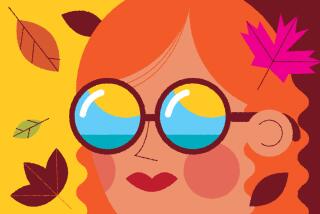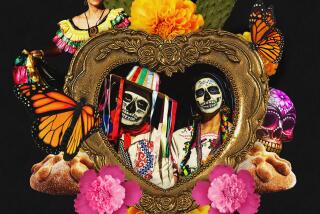More Celebrate Day of the Dead to Find Solace
Teri Maldonado Parker celebrates Day of the Dead for deeply personal reasons.
Though she is Mexican American, her husband was not. A Vietnam veteran, he committed suicide after suffering post-traumatic stress syndrome. And she lost their 3-month-old son on Nov. 2, 1972, to crib death.
Four years ago, she decided to make an ofrenda, a personalized altar, for them both in her Santa Ana home.
“Losing my son so close to the Day of the Dead really stuck with me,” Parker said. “I heard about the Day of the Dead, but I never practiced it. It wasn’t passed on in my family. But I researched it and made an altar for them both. I put their pictures on it, and personal items from both. It helped so much.”
Parker is one of an increasing number of people in Southern California and across the United States who have discovered solace and comfort in the Mexican holiday’s ritualized acceptance of mortality.
“I found it to be very therapeutic, all of a sudden, to be able to share my loss with other people,” said Parker, who now volunteers at the Bowers Museum of Cultural Art celebration of the holiday.
“It’s remembering what they were to you in a very positive way that is not morbid at all.”
As part of its growing popularity, the holiday also is becoming a crossover occasion appropriated by those who have transformed Halloween from a children’s trick-or-treat to an adult costume ball.
This year, U.S. tourists are making the pilgrimage to the world-famous Day of the Dead epicenter, Oaxaca, Mexico. Families in Palm Springs can head to the local museum Sunday to view altars to the dead. In Los Angeles, revelers can choose between Halloween and Dia de los Muertos parties, and some fetes are mixing Mexican altars with American masquerade.
Rooted in pre-Columbian Mexico, the Day of the Dead is a time when families honor deceased loved ones. Cemeteries fill with candles, marigolds and relatives who picnic by tombstones, setting a place for the deceased or even speaking to them. Home altars display photos of those who have died. Special poems are written, often about the imagined death of someone still living.
The holiday’s growing popularity in the United States is a “cultural crisscross, like the American taco,” said Tomas Benitez, the director of Self-Help Graphics in East Los Angeles, which will host one of the city’s biggest celebrations Sunday. “The Day of the Dead is becoming more and more widespread. It’s not just something for Latinos anymore.
“It can be unique in its Mexican Latino identity, and at the same time not just for Latinos in its audience,” Benitez said. “That’s what sharing culture is all about.”
At Santa Ana’s Bowers Museum, Parker is organizing Sunday’s celebration and will be dressed as “La Catrina,” a mythic skeleton figure with a huge adorned hat and a colorful feather boa.
She also will be creating an ofrenda to remember war veterans, “not just to Hispanic men but to all men who fought, who laid down their lives for their country.”
She has asked her American Legion branch, Post 291 of Newport Beach, to participate.
As for the holiday’s increasing popularity with non-Mexican Americans, she is overjoyed.
“I’m so glad it belongs to everybody. . . . It’s a wonderful way to share. I was discussing the Day of the Dead with a Korean gentleman, and he told me they set up a table for their dead too. It just shows you this is an experience we all share, the loss of our beloved, and the time we take to remember them.”
In Los Angeles, the Day of the Dead is anything but. The festival has moved out of its traditional haunts--Olvera Street and East Los Angeles--and made inroads into Santa Monica schoolrooms, Silver Lake galleries, and parks and community centers in Pasadena and San Fernando.
It is even creeping into the Los Angeles “Gothic” youth cult among those who affect, along with heavy eyeliner and black fingernail polish, a privileged disaffection with American consumer culture. Like Seth “the Goth King” Lindberg, for whom Halloween is so over.
“I pretended for a little while that Halloween was about something more than candy and Power Rangers masks, but it wasn’t,” Lindberg wrote in a Web site essay. “The Day of the Dead is different. It’s really cool. Festivals like these thrive on the fact that they haven’t entered into the strip-mall mentality of America.”
“This is a festival that hasn’t been touched by Hallmark,” Lindberg wrote. “A real and honest celebration, not a cardboard cutout or a placating placebo shunting individuality for some homogenized dream of plastic masks.”
Some parties are mixing the holidays. An Echo Park fete is billed as a “Dia de los Muertos Halloween Fun House Party.” Two Venice screenwriters will have a Day of the Dead altar at their Halloween masquerade.
Benitez went to the Halloween party at Montebello Park Elementary School in East Los Angeles. His son’s class also had made an altar.
“He’s gotta be Godzilla” for Halloween, Benitez said of the boy. “We are Americans, after all. But I would like to see the Day of the Dead impacting schools more broadly. Some of the traditions coming from Latin American countries probably justify a greater place in the schools.”
And though both holidays spring from ancient equinox rites with Christian veneers, Halloween cannot provide children with the same spiritual orientation, Benitez said.
“The modern context of Halloween--ghouls and goblins and pumpkins--is not the same,” Benitez said. “The Day of the Dead is not about ghouls and goblins, it’s about life and death. In celebrating death, you are celebrating life as part of the same cycle, welcoming death as part of life.”
Times staff writer Robert Lopez and researchers Scott Wilson, Chuck Holmes and Steve Tice contributed to this report.
(BEGIN TEXT OF INFOBOX / INFOGRAPHIC)
Dead Doings
The Bowers Museum of Cultural Art will hold a series of Day of the Dead festivities this weekend in the Museum courtyard. There is no charge, but admission to museum exhibits is $6 for adults, $4 for students and seniors, $2 for children. The museum is at 20th and North Main streets in Santa Ana. Information: (714) 567-3600
Today
11 a.m.-4 p.m.
Kidseum activities include art projects, calavera (skeleton) face painting, Mexican tales, sweet bread and hot chocolate
Sunday
Noon--4 p.m.
* Las Amigas de Cultura will exhibit and discuss ofrendas (altars for the departed)
* Lecture on “The Significance of Remembering”
* Society of Hispanic Historical and Ancestral research will provide information on tracing your roots and will announce poetry contest winners
* Singers and dancers will perform, and traditional food and drink, including sugar skulls and Bread of the Dead, will be available
* Kidseum will hold a workshop, and there will be a parade for children to show off their masks
More to Read
Sign up for Essential California
The most important California stories and recommendations in your inbox every morning.
You may occasionally receive promotional content from the Los Angeles Times.










